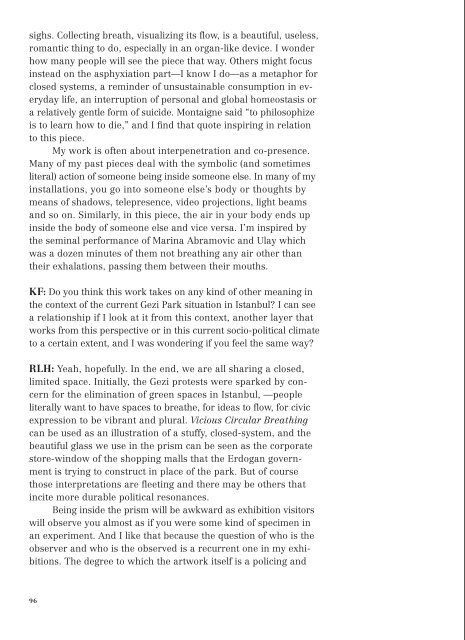Create successful ePaper yourself
Turn your PDF publications into a flip-book with our unique Google optimized e-Paper software.
sighs. Collecting breath, visualizing its flow, is a beautiful, useless,<br />
romantic thing to do, especially in an organ-like device. I wonder<br />
how many people will see the piece that way. Others might focus<br />
instead on the asphyxiation part—I know I do—as a metaphor for<br />
closed systems, a reminder of unsustainable consumption in everyday<br />
life, an interruption of personal and global homeostasis or<br />
a relatively gentle form of suicide. Montaigne said “to philosophize<br />
is to learn how to die,” and I find that quote inspiring in relation<br />
to this piece.<br />
My work is often about interpenetration and co-presence.<br />
Many of my past pieces deal with the symbolic (and sometimes<br />
literal) action of someone being inside someone else. In many of my<br />
installations, you go into someone else’s body or thoughts by<br />
means of shadows, telepresence, video projections, light beams<br />
and so on. Similarly, in this piece, the air in your body ends up<br />
inside the body of someone else and vice versa. I’m inspired by<br />
the seminal performance of Marina Abramovic and Ulay which<br />
was a dozen minutes of them not breathing any air other than<br />
their exhalations, passing them between their mouths.<br />
KF: Do you think this work takes on any kind of other meaning in<br />
the context of the current Gezi Park situation in Istanbul? I can see<br />
a relationship if I look at it from this context, another layer that<br />
works from this perspective or in this current socio-political climate<br />
to a certain extent, and I was wondering if you feel the same way?<br />
RLH: Yeah, hopefully. In the end, we are all sharing a closed,<br />
limited space. Initially, the Gezi protests were sparked by concern<br />
for the elimination of green spaces in Istanbul, —people<br />
literally want to have spaces to breathe, for ideas to flow, for civic<br />
expression to be vibrant and plural. Vicious Circular Breathing<br />
can be used as an illustration of a stuffy, closed-system, and the<br />
beautiful glass we use in the prism can be seen as the corporate<br />
store-window of the shopping malls that the Erdogan government<br />
is trying to construct in place of the park. But of course<br />
those interpretations are fleeting and there may be others that<br />
incite more durable political resonances.<br />
Being inside the prism will be awkward as exhibition visitors<br />
will observe you almost as if you were some kind of specimen in<br />
an experiment. And I like that because the question of who is the<br />
observer and who is the observed is a recurrent one in my exhibitions.<br />
The degree to which the artwork itself is a policing and<br />
96<br />
Rafael Lozano-Hemmer, Respiración circular y viciosa—Vicious Circular Breathing, 2013 [Cat. 39]<br />
97


